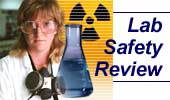LAB SAFETY REVIEW: Pros And Cons Of Lab Glove Materials

Written by Bruce Bahman, Technical Services, Lab Safety Supply

Lab Safety Review is a new monthly column on Safety Online and Laboratory Network.com. Each edition is written by a specialist in this important field. This is the second installment of the January column.
When selecting the best glove for your application, consider the factors detailed in LAB SAFETY REVIEW: Selecting Chemical- Resistant Lab Gloves. There are currently eight main types of glove materials available. These are the eight types and the general applications for which they are used:
- Natural Latex—A natural rubber material that offers good resistance to many acids and bases when it is used in a reusable glove. Latex gloves offer very limited chemical resistance. Natural rubber offers reasonable abrasion resistance.
- Butyl—A synthetic rubber material that offers the highest permeation resistance to gas and water vapors of all of the materials. This is especially suited for use with esters and ketones.
- Neoprene—A synthetic rubber material that provides excellent tensile strength and heat resistance. Neoprene is well suited for many acids and caustics. It offers moderate abrasion resistance.
- Nitrile—A synthetic rubber material that offers resistance to a variety of chemicals and good resistance to abrasion. It makes a good general-duty glove.
- Polyvinyl Chloride (PVC)—A synthetic thermoplastic polymer that provides excellent resistance to most acids and fats, and many hydrocarbons.
- Polyvinyl Alcohol (PVA)—A water-soluble material that is highly impermeable to gases. It provides excellent chemical resistance to aromatic and chlorinated solvents. These gloves cannot be used in water or water-based solutions.
- Viton—A fluoroelastomer material that provides exceptional chemical resistance to chlorinated and aromatic solvents. Viton is very flexible, but has limited cut and abrasion resistance.
- Silvershield/4H/Barrier—These lightweight gloves, constructed from patented laminate materials, offer the highest level of overall chemical resistance. However, they offer poor abrasion and cut resistance. Often, a second glove with better grip properties or abrasion resistance is used over these gloves.
Any of these gloves will degrade with repeated exposure to chemicals. It is important to inspect the gloves before use for signs of physical degradation. They must be replaced at the first signs of breakdown.
Once researchers determine the type of material for their gloves, they must make several other choices to determine which gloves are best suited for their application:
- Thickness—Take into account the dexterity needed for the task. The thicker the glove, the better the chemical resistance (in general). However, thicker gloves offer less dexterity. Disposable latex or nitrile gloves are usually designed to offer splash protection only and should not be used for constant contact with chemicals.
- Length—For general laboratory use, a 10-14-in long glove will be sufficient. For deep-tank cleaning, acid washing, or additional splash protection, up to a 31-inch long glove may be required.
- Temperature resistance—A glove with a cotton liner may be appropriate for elevated temperatures. A heat-resistant overglove may also be required where high temperatures can be expected.
- Abrasion Resistance—Some glove materials may offer good chemical resistance but lack the abrasion resistance required for the application. In this case, a different material may be chosen, or a second glove with acceptable abrasion resistance could be used as an overglove.
The use of the appropriate chemical-resistant glove(s) can greatly reduce the health hazards facing scientists in both research and industry.
Lab Safety Supply has a team of technical representatives who have access to the latest data available to help researchers select the most appropriate gloves for their applications.
For more information, contact the Lab Safety Supply Technical Services Department by calling 800-356-2501.
Author Bruce Bahman can be reached at B.Bahman@LabSafety.com. Laura Vandendorpe, the managing editor of Laboratory Network.com, can be reached at lvandendorpe@vertical.net.
